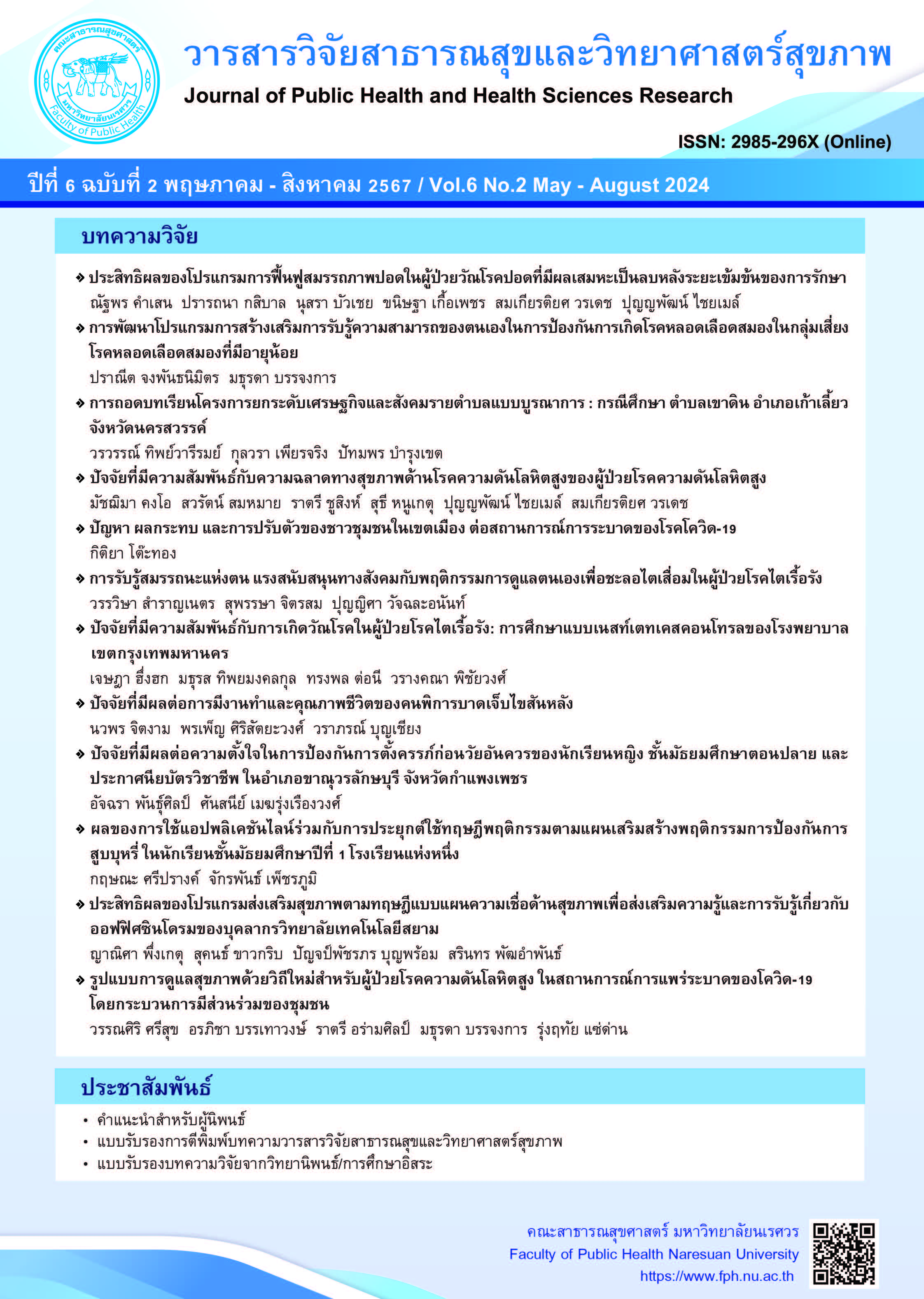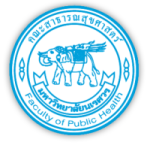Effectiveness of pulmonary rehabilitation program among pulmonary tuberculosis patients with negative sputum after intensive of treatment period
Keywords:
Pulmonary rehabilitation, Sputum examination, Intensive treatment period, TuberculosisAbstract
The purpose of this one-group pretest-posttest experimental study was to compare the scores of the knowledge related to pulmonary tuberculosis and the average scores of pulmonary functions among patients with pulmonary tuberculosis before and after receiving a pulmonary rehabilitation program. A total of 20 patients with pulmonary tuberculosis who tested negative for sputum after the intensive treatment period were selected using purposive sampling at Hua Sai Hospital, Hua Sai District, Nakhon Si Thammarat Province. The data were collected between December 2022 and February 2023. The research instruments consisted of 1) The pulmonary tuberculosis rehabilitation program for 8 weeks, and 2) data collection, including questionnaires on demographic characteristics, knowledge related to tuberculosis, and pulmonary function tests. The questionnaire was reviewed by three experts, and the content validity ranged from 0.67 to 1.00. The coefficient of Kruder-Richarson-20 for knowledge related to pulmonary tuberculosis was 0.70. Pulmonary function was assessed using a Peak flow meter. The data were analyzed using descriptive statistics and a paired t-test.
The results found that the subjects had significantly increased scores of the knowledge related to pulmonary tuberculosis and pulmonary function after receiving the pulmonary rehabilitation program (p-value < 0.001, p-value = 0.001, respectively). The study suggests that health professionals responsible for tuberculosis care should implement the pulmonary tuberculosis rehabilitation program to enhance and improve pulmonary function among patients with pulmonary tuberculosis who tested negative for sputum after the intensive treatment period.
References
Best, J. (1977). Research in education. (3rd ed.). Englewood cliffs, New Jersey: Prentice-Hall.
Chantana, N., Maneesriwongul, W., & Putawatana, P. (2019). Factors related to adherence to multi-drug resistant tuberculosis treatment. Ramathibodi Nursing Journal, 25(3), 296-309. (in Thai)
Department of Disease Control. (2017). Psychosocial factors attitudes related to patient counseling. TB and drug-resistant tuberculosis work consulting guide for health personnel. (2nd ed). Bangkok: Aksorn graphic and design publishing limited partnership. (in Thai)
Division of Tuberculosis, Department of Disease Control & Ministry of Public Health. (2021, April 1). Situation reports and surveillance tuberculosis Thailand. Retrieved October 19, 2022, from https://www.tbthailand.org/download/Manual/Thailand%20Operational%20Plan%20To%20End%20%20TB_2017_2021.pdf (in Thai)
Ekajit, A., Moongtui, W., & Boonchieng, W. (2013). Comparison of effects of self-regulation with education and education on practices in prevention of infection transmission among pulmonary tuberculosis patients. Nursing Journal, 40(4), 1-11. (in Thai)
Intajak. T., (2021). Herbal used behavior of people in Mueang District, Mae Hong Son Province. Retrieved November 2, 2022, from http://cmruir.cmru.ac.th/handle/123456789/2248 (in Thai)
Lomaneenopparat, R., (2015). Outcomes of pulmonary rehabilitation program in outcomes of pulmonary rehabilitation program in COPD patients at Makarak Hospital. Region 4-5 Medical Journal, 34(1), 2-10. (in Thai)
Ministry of Public Health. (2018). Guidelines for the prevention and control of tuberculosis and common communicable diseases in educational institutions. Bangkok: Art Qualified Company Limited. (in Thai)
Phuvipirome, T., Chalanuwat, C., & Jarusombat, L., (2014). Effects of a pulmonary rehabilitation program with palunglompran on exercise tolerance, dyspnea, and self-efficacy to control dyspnea in patients with chronic obstructive pulmonary disease. Nursing Journal of the Ministry of Public Health, 24(1), 149-161. (in Thai)
Riyapan, M., Woradet, S., & Chaimay, B., (2021). Multidrug resistant among patients with pulmonary tuberculosis: Literature review. Academic Journal of Community Public Health, 7(4), 1-16. (in Thai)
Sritawan, R., & Chiopanya, N (2021). The effectiveness of a motivational interviewing program on knowledge, medication adherence, and the prevention of disease transmission among persons with tuberculosis. Journal of Nursing and Public Health Research, 1(3), 17-30. (in Thai)
Thanawong, L., Nantachaipan, P., & Soivong, P., (2016). Effects of a self-management promotion in pulmonary rehabilitation on functional capacity and health care utilization among persons with chronic obstructive pulmonary disease. Nursing Journal. 43(2), 45-56. (in Thai)
Thammiganont, J., Chaisawat, P., Sereethammapithak, P., Wongsricha, W., & Seansupha, W. (2021). The development of guidelines for caring for new pulmonary tuberculosis patientsat risk of dying during treatment Nakhon Phanom Province. Journal of Environmental and Community Health, 6(3), 23. (in Thai)
World Health Organization. (2022). Tuberculosis. Retrieved September 27, 2022, from https://www.who.int/health-topics/tuberculosis# tab=tab_1
Downloads
Published
How to Cite
Issue
Section
License
Copyright (c) 2024 Journal of Public Health and Health Sciences Research

This work is licensed under a Creative Commons Attribution-NonCommercial-NoDerivatives 4.0 International License.
The published article is copyrighted by the Journal of Public Health and Health Sciences Research.
The statements that appear in each article in this academic and research journal are the personal opinions of each author and are not related to Naresuan University and other faculty members in the university. Responsibilities regarding each article are the responsibility of each author.






